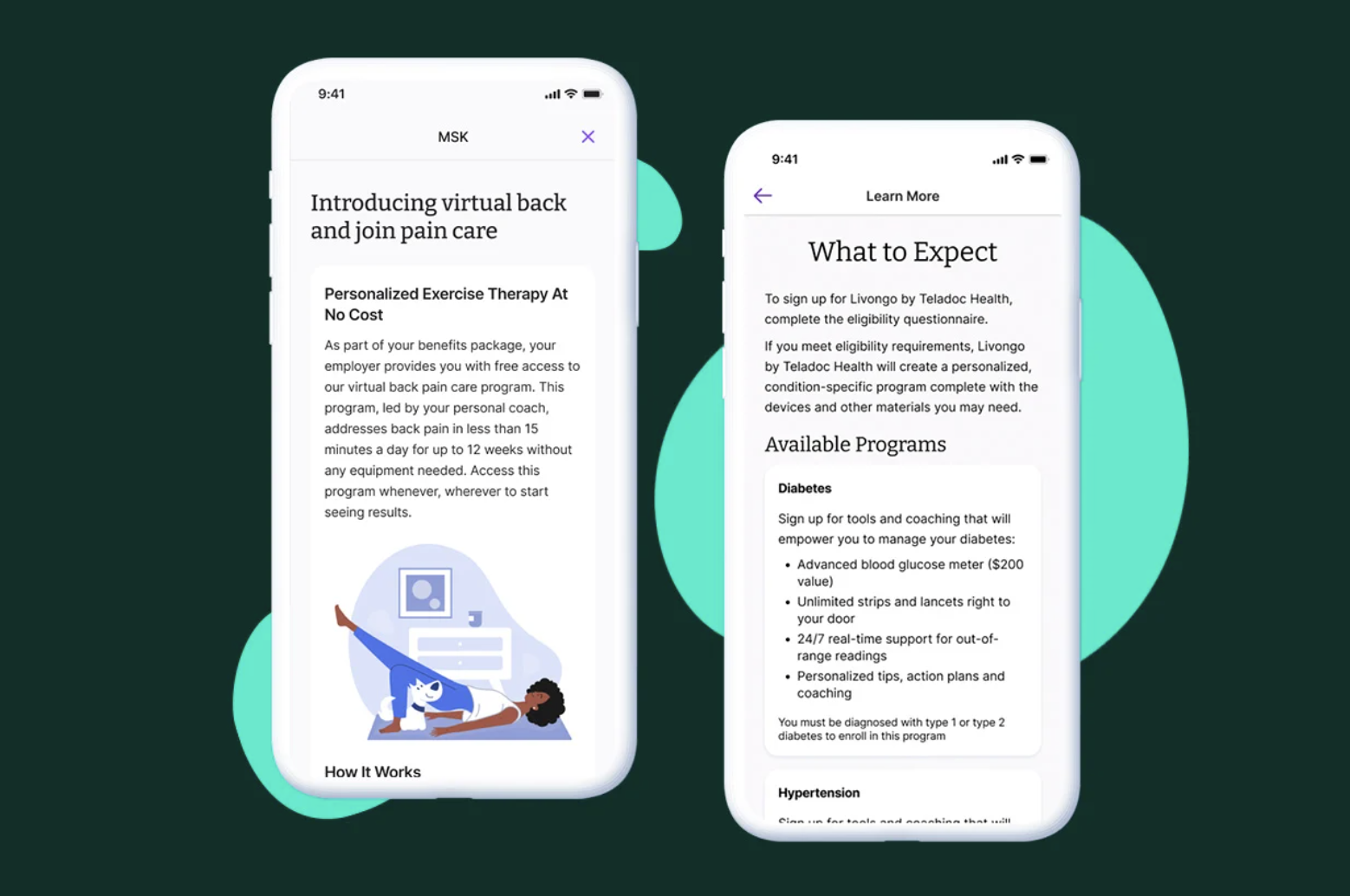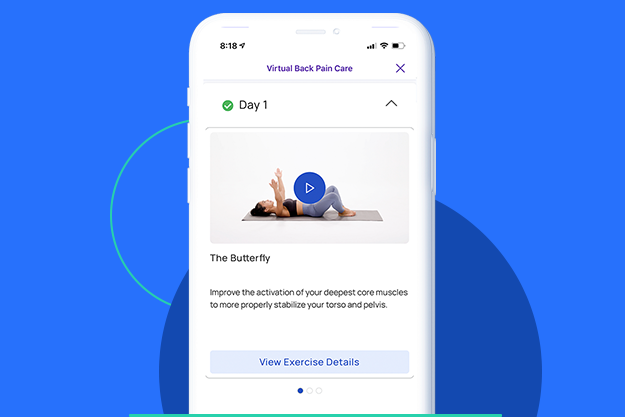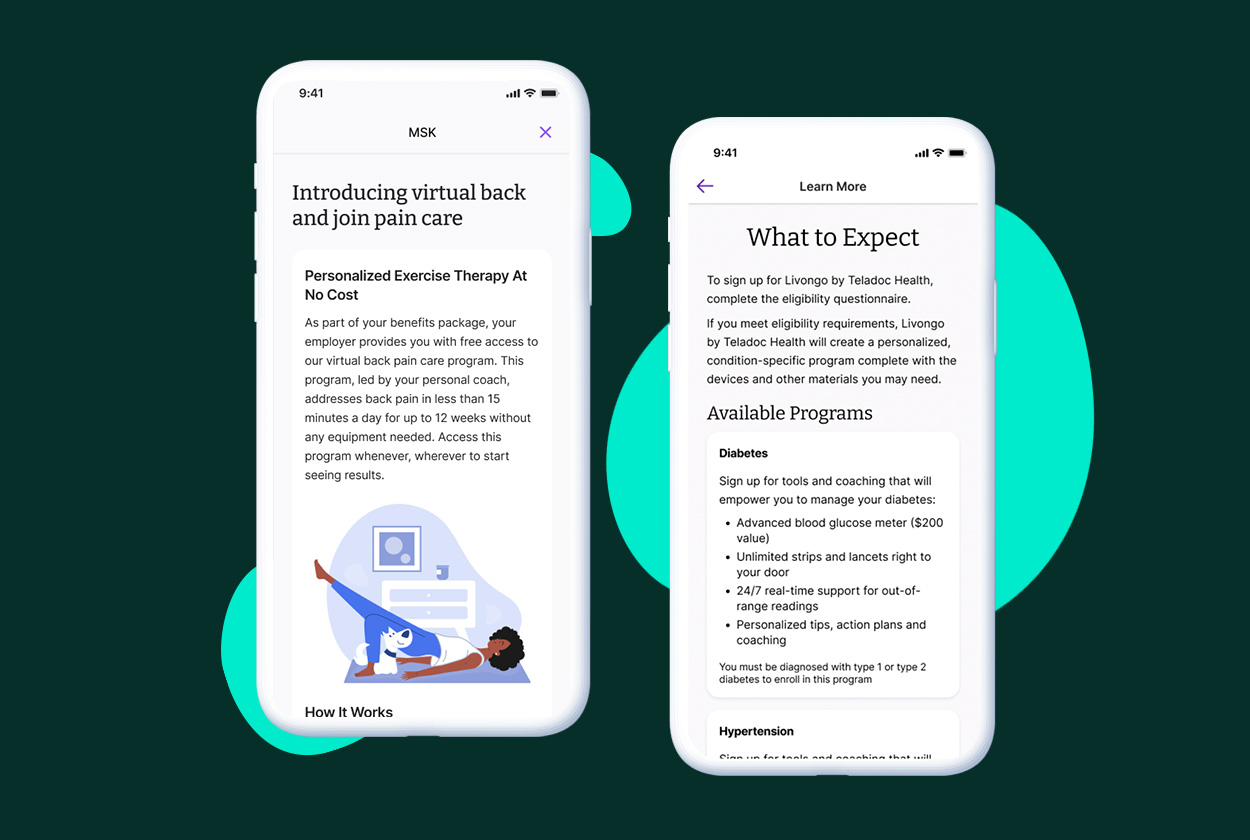Introducing HealthJoy’s Virtual MSK Care
Chronic pain can be a pain. For an estimated 126.6 million Americans suffering from a musculoskeletal (MSK) condition, finding a better way to...
Connected Navigation Platform
Guiding to high-value care
Behavioral Health
Foster a mentally healthy workplace
EAP
Supporting holistic wellbeing
Virtual MSK Care
Reimagining musculoskeletal care
Virtual Primary Care
Powered by smart navigation
Surgery Centers of Excellence
Best-in-class surgical outcomes
Virtual Urgent Care
Immediate care, any hour of the day
Chronic Care
A new approach to chronic care
Integrations
Flexible to any strategy

Musculoskeletal (MSK) conditions affect millions of Americans each year. Representing over $380 billion in total annual expense, lower-back pain, neck pain, muscle pain and other MSK disorders consistently rank among the most costly categories of care in the United States.
Musculoskeletal pain and disorders require 38% more time away from work than the average injury, cutting into workplace productivity. Back pain alone results in an estimated 83 million missed work days each year. Employees with these conditions are more likely to see higher healthcare spending than other areas, due to lower overall physical health and higher rates of related conditions, such as depression.
Because of this, it’s not surprising that nearly 80% of employers are either currently offering, or interested in offering an MSK solution. HealthJoy’s innovative Virtual MSK Therapy offers your employees relief through a program that connects the brain and body to treat these conditions, leading to better pain reduction than similar solutions in just 15 equipment-free minutes per day.
HealthJoy’s Virtual MSK Therapy connects employees with the only program on the market combining common stretches and exercises with a neurological approach to address the root cause of pain. HealthJoy’s approach is guided by the philosophy that targeting functional changes in the brain in response to pain and injury is more effective than the current standard of care. Our programming stands out because it targets the brain alongside the muscle, joint and tendon.
Chronic pain—the kind that causes persistent musculoskeletal problems such as back, neck, knee, or ankle issues — involves both the body parts where we feel pain and pain signals in the brain. After six months from the onset of joint or muscle injury, the body parts have healed but the pain persists because of changes in the brain. Yet many orthopedic rehab approaches isolate the body part rather than treating a whole. They focus only on the second step in our process — the conditioning exercises — to improve a body part’s level of pain, range of motion and strength.
However, these approaches skip a key first step – making sure that the brain’s pain and function signals are in sync with the body. Without this foundation, improvements are limited because no amount of additional muscle will address the neurological foundation of pain.
HealthJoy’s Virtual MSK Therapy includes three key steps, two of which are unique to our program. Taken together with traditional conditioning exercises, this coach-led approach achieves greater pain relief and improved function.
The global motor system refers to the concept that when multiple parts of the body must work together, they engage a different system in your brain than when those parts work in isolation. Lifting a glass of water while sitting still involves the local motor system.
During this action, a single system in your brain is engaged to move your shoulder. Reaching for a glass of water while mid-stride on a marathon course engages the global system motor system, which works to coordinate all of those movements.
We begin to lay a strong foundation by targeting the global motor system before digging into stretch-and-strengthen approaches. These exercises consist of isometric holds - repeatedly holding a static position rather than moving throughout the exercise - in postures that engage different circuits of the global motor system.
By the end of this phase, HealthJoy averages the same level of improvement as other programs see after their entire, conditioning-oriented programs.
Improving the global motor system removes the ceiling and accelerates progress and pain relief once we move into stretching and strengthening the areas where our members are experiencing pain. Our coaches create a custom exercise program for members to follow for three to five days a week.
These 15-minute sessions are designed to be simple and effective. These are the types of exercises you may see in a standard strength workout, such as planks or squats. It’s undoubtedly useful to improve strength and flexibility, but most traditional in-person approaches stop there. Because they don’t tap into the global and local motor systems, many people experience a plateau after an initial gain in strength and flexibility.
In this phase, we draw upon principles of the Cross-Education Effect. This describes a gain in function on an injured limb when you are exercising the non-injured limb. In a traditional injury, you might hurt your right arm, wear a cast, lose function in that arm and see that muscle atrophy. But there’s another approach: Miraculously, exercising the left arm while the right arm is in a cast reduces the atrophy.
Some of the strength gained in the left arm translates to the right arm, even when you aren’t exercising your right. This effect exists because both hemispheres of the brain - and body - talk to each other. When neurons fire on one side of the brain, they can jumpstart the other side to improve function. We engage this local motor system to improve pain and function and prevent future injury.
It’s possible to reduce pain in the hip, neck, back or ankle through traditional “stretch and strengthen” approaches. These improvements are the hallmark of traditional physical therapy (PT) programs and factor into our approach as well. While they might end pain in the clinic and certainly improve pain overall, they stop short of creating the neurological changes required to reduce pain and improve function when these body parts are moving the way they should — with each other.
In the real world, unlike in the controlled environment of a physical therapy (PT) clinic, our motions are dynamic. To achieve more effective pain relief, our exercise program targets functional changes in both the individual parts of the body and the connected systems at the root of pain.
People seeking relief from MSK pain are often presented with few options.
Traditional physical rehabilitation (PT) programs focus on reducing pain and improving function by strengthening and stretching parts of the body. While this approach is excellent for many populations, working body parts in isolation does not produce significant, long-term results for chronic pain. In fact, the “standard of care,” or goal, for chronic pain management is just over a 50% improvement.
Surgery is another option for those suffering from chronic pain. But in addition to being costly and invasive, this method of treatment is also surprisingly unsuccessful. Back surgeries so often fail—one study estimated that 50% don’t deliver the desired result—that researchers have developed the term “failed back syndrome” to describe the phenomenon.
Other MSK solutions target pain reduction close to this baseline of 50%, as well. Early graduates of HealthJoy’s Virtual MSK Therapy program have seen an average 85% improvement in their pain - all without complicated equipment.
HealthJoy’s solution is a coach-led, virtual exercise therapy program intended to minimize barriers to member participation while delivering the best programming for improved outcomes.
Through innovative and connected programming that engages both the body and the brain, we’re able to deliver results that exceed both the standard of care and competitor success rates. Plus, HealthJoy does it all with less travel, wait time and billing confusion than traditional in-person care.
Because the experience is accessed through our integrated healthcare navigation platform, it’s linked to proactive communication tools that drive adherence and encourage program completion — a major barrier to success for traditional in-person PT.
Before members kick off their individualized MSK care, members start with an onboarding survey and initial consultation with their coach. From there, members are guided through daily 15-minute exercises that target their back, neck, knee, shoulder, hip, elbow, hand, wrist, foot or ankle pain. These exercises don’t require equipment, sensors, or in-person visits to achieve improvements in pain reduction and range of motion.
Want to learn more about how HealthJoy’s innovative approach drives results in just 15 minutes per day? See Virtual MSK Therapy in Action during a HealthJoy Demo!

Chronic pain can be a pain. For an estimated 126.6 million Americans suffering from a musculoskeletal (MSK) condition, finding a better way to...

As always, I’m excited to share some of HealthJoy’s latest product updates and enhancements, but I’m particularly excited about the timing of this...

Suffering from a musculoskeletal (MSK) condition can make it feel like you’re on the sidelines in your own life. This pain can take you away from the...